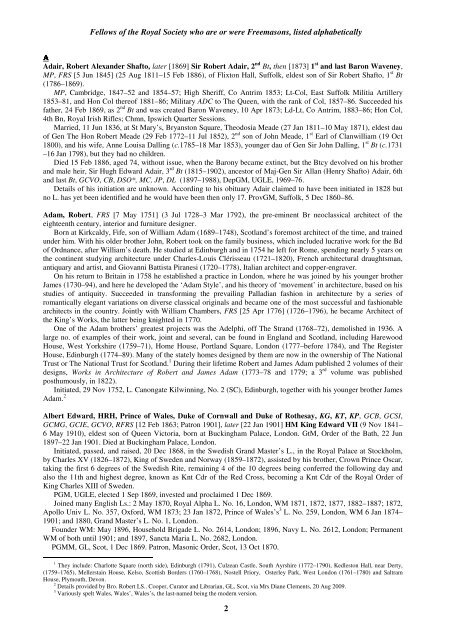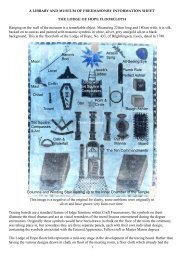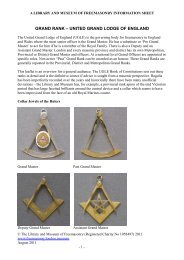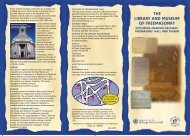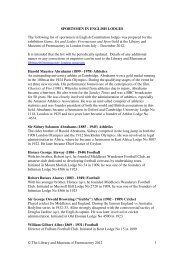FREEMASONS AND THE ROYAL SOCIETY Alphabetical List of ...
FREEMASONS AND THE ROYAL SOCIETY Alphabetical List of ...
FREEMASONS AND THE ROYAL SOCIETY Alphabetical List of ...
Create successful ePaper yourself
Turn your PDF publications into a flip-book with our unique Google optimized e-Paper software.
Fellows <strong>of</strong> the Royal Society who are or were Freemasons, listed alphabetically<br />
A<br />
Adair, Robert Alexander Shafto, later [1869] Sir Robert Adair, 2 nd Bt, then [1873] 1 st and last Baron Waveney,<br />
MP, FRS [5 Jun 1845] (25 Aug 1811–15 Feb 1886), <strong>of</strong> Flixton Hall, Suffolk, eldest son <strong>of</strong> Sir Robert Shafto, 1 st Bt<br />
(1786–1869).<br />
MP, Cambridge, 1847–52 and 1854–57; High Sheriff, Co Antrim 1853; Lt-Col, East Suffolk Militia Artillery<br />
1853–81, and Hon Col there<strong>of</strong> 1881–86; Military ADC to The Queen, with the rank <strong>of</strong> Col, 1857–86. Succeeded his<br />
father, 24 Feb 1869, as 2 nd Bt and was created Baron Waveney, 10 Apr 1873; Ld-Lt, Co Antrim, 1883–86; Hon Col,<br />
4th Bn, Royal Irish Rifles; Chmn, Ipswich Quarter Sessions.<br />
Married, 11 Jun 1836, at St Mary’s, Bryanston Square, Theodosia Meade (27 Jan 1811–10 May 1871), eldest dau<br />
<strong>of</strong> Gen The Hon Robert Meade (29 Feb 1772–11 Jul 1852), 2 nd son <strong>of</strong> John Meade, 1 st Earl <strong>of</strong> Clanwilliam (19 Oct<br />
1800), and his wife, Anne Louisa Dalling (c.1785–18 Mar 1853), younger dau <strong>of</strong> Gen Sir John Dalling, 1 st Bt (c.1731<br />
–16 Jan 1798), but they had no children.<br />
Died 15 Feb 1886, aged 74, without issue, when the Barony became extinct, but the Btcy devolved on his brother<br />
and male heir, Sir Hugh Edward Adair, 3 rd Bt (1815–1902), ancestor <strong>of</strong> Maj-Gen Sir Allan (Henry Shafto) Adair, 6th<br />
and last Bt, GCVO, CB, DSO*, MC, JP, DL (1897–1988), DepGM, UGLE, 1969–76.<br />
Details <strong>of</strong> his initiation are unknown. According to his obituary Adair claimed to have been initiated in 1828 but<br />
no L. has yet been identified and he would have been then only 17. ProvGM, Suffolk, 5 Dec 1860–86.<br />
Adam, Robert, FRS [7 May 1751] (3 Jul 1728–3 Mar 1792), the pre-eminent Br neoclassical architect <strong>of</strong> the<br />
eighteenth century, interior and furniture designer.<br />
Born at Kirkcaldy, Fife, son <strong>of</strong> William Adam (1689–1748), Scotland’s foremost architect <strong>of</strong> the time, and trained<br />
under him. With his older brother John, Robert took on the family business, which included lucrative work for the Bd<br />
<strong>of</strong> Ordnance, after William’s death. He studied at Edinburgh and in 1754 he left for Rome, spending nearly 5 years on<br />
the continent studying architecture under Charles-Louis Clérisseau (1721–1820), French architectural draughtsman,<br />
antiquary and artist, and Giovanni Battista Piranesi (1720–1778), Italian architect and copper-engraver.<br />
On his return to Britain in 1758 he established a practice in London, where he was joined by his younger brother<br />
James (1730–94), and here he developed the ‘Adam Style’, and his theory <strong>of</strong> ‘movement’ in architecture, based on his<br />
studies <strong>of</strong> antiquity. Succeeded in transforming the prevailing Palladian fashion in architecture by a series <strong>of</strong><br />
romantically elegant variations on diverse classical originals and became one <strong>of</strong> the most successful and fashionable<br />
architects in the country. Jointly with William Chambers, FRS [25 Apr 1776] (1726–1796), he became Architect <strong>of</strong><br />
the King’s Works, the latter being knighted in 1770.<br />
One <strong>of</strong> the Adam brothers’ greatest projects was the Adelphi, <strong>of</strong>f The Strand (1768–72), demolished in 1936. A<br />
large no. <strong>of</strong> examples <strong>of</strong> their work, joint and several, can be found in England and Scotland, including Harewood<br />
House, West Yorkshire (1759–71), Home House, Portland Square, London (1777–before 1784), and The Register<br />
House, Edinburgh (1774–89). Many <strong>of</strong> the stately homes designed by them are now in the ownership <strong>of</strong> The National<br />
Trust or The National Trust for Scotland. 1 During their lifetime Robert and James Adam published 2 volumes <strong>of</strong> their<br />
designs, Works in Architecture <strong>of</strong> Robert and James Adam (1773–78 and 1779; a 3 rd volume was published<br />
posthumously, in 1822).<br />
Initiated, 29 Nov 1752, L. Canongate Kilwinning, No. 2 (SC), Edinburgh, together with his younger brother James<br />
Adam. 2<br />
Albert Edward, HRH, Prince <strong>of</strong> Wales, Duke <strong>of</strong> Cornwall and Duke <strong>of</strong> Rothesay, KG, KT, KP, GCB, GCSI,<br />
GCMG, GCIE, GCVO, RFRS [12 Feb 1863; Patron 1901], later [22 Jan 1901] HM King Edward VII (9 Nov 1841–<br />
6 May 1910), eldest son <strong>of</strong> Queen Victoria, born at Buckingham Palace, London. GtM, Order <strong>of</strong> the Bath, 22 Jun<br />
1897–22 Jan 1901. Died at Buckingham Palace, London.<br />
Initiated, passed, and raised, 20 Dec 1868, in the Swedish Grand Master’s L., in the Royal Palace at Stockholm,<br />
by Charles XV (1826–1872), King <strong>of</strong> Sweden and Norway (1859–1872), assisted by his brother, Crown Prince Oscar,<br />
taking the first 6 degrees <strong>of</strong> the Swedish Rite, remaining 4 <strong>of</strong> the 10 degrees being conferred the following day and<br />
also the 11th and highest degree, known as Knt Cdr <strong>of</strong> the Red Cross, becoming a Knt Cdr <strong>of</strong> the Royal Order <strong>of</strong><br />
King Charles XIII <strong>of</strong> Sweden.<br />
PGM, UGLE, elected 1 Sep 1869, invested and proclaimed 1 Dec 1869.<br />
Joined many English Ls.: 2 May 1870, Royal Alpha L. No. 16, London, WM 1871, 1872, 1877, 1882–1887; 1872,<br />
Apollo Univ L. No. 357, Oxford, WM 1873; 23 Jan 1872, Prince <strong>of</strong> Wales’s 3 L. No. 259, London, WM 6 Jan 1874–<br />
1901; and 1880, Grand Master’s L. No. 1, London.<br />
Founder WM: May 1896, Household Brigade L. No. 2614, London; 1896, Navy L. No. 2612, London; Permanent<br />
WM <strong>of</strong> both until 1901; and 1897, Sancta Maria L. No. 2682, London.<br />
PGMM, GL, Scot, 1 Dec 1869. Patron, Masonic Order, Scot, 13 Oct 1870.<br />
1 They include: Charlotte Square (north side), Edinburgh (1791), Culzean Castle, South Ayrshire (1772–1790), Kedleston Hall, near Derty,<br />
(1759–1765), Mellerstain House, Kelso, Scottish Borders (1760–1768), Nostell Priory, Osterley Park, West London (1761–1780) and Saltram<br />
House, Plymouth, Devon.<br />
2 Details provided by Bro. Robert LS.. Cooper, Curator and Librarian, GL, Scot, via Mrs Diane Clements, 20 Aug 2009.<br />
3 Variously spelt Wales, Wales’, Wales’s, the last-named being the modern version.<br />
2


